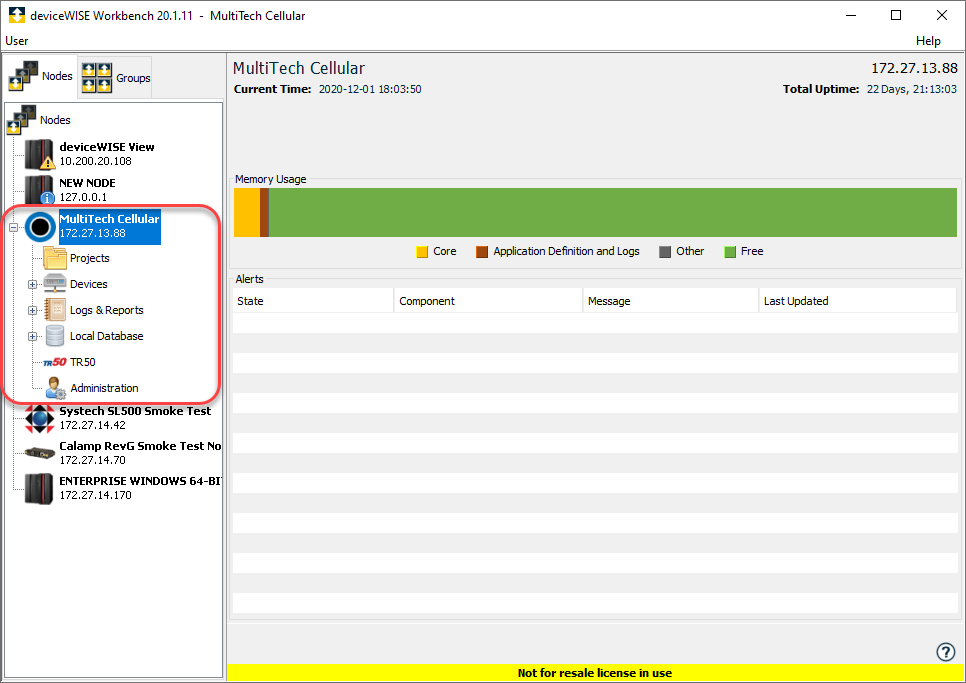The IoT Gateway User Guide introduces the Workbench configuration and diagnostic tool, and then covers the features you will use to create and support an IoT solution. The features are presented in this guide as they are accessed using the Workbench.

The features displayed by the Workbench for a node are
based on the specific features that are available and
enabled on that node.
Your IoT solution's life cycle
The information contained in this IoT Gateway User's Guide and the other sections of this information site are meant to help you define, implement, test, and support your IoT solution. There are different ways to progress through the solution's lifecycle by starting with any of the features first and then continuing with the other features. This sequence of features focused on first, and then iterated and refined as additional features are included may be driven by your current environment:
- Do you have an existing data collection environment that you will use for access to the devices, sensors, and other data sources?
- Do you have existing enterprise applications that have interfaces and structure that you will reuse?
- Is there a need for edge-based processing of the
data before it is forwarded to the enterprise
level?
Similarly, is there a need for edge-based processing of data received from the enterprise level before it is forwarded to the data collection environment?
The term edge-based processing is used to mean business logic processing close to (at the edge) the devices, sensors, and other data sources. - Is there a future expansion of the solution that will take place at a later time?
Your IoT business requirements
The specific business requirements you are solving will dictate the features you will use in your IoT solution. For example, if you have a requirement to send as built data to an Oracle database because you have enterprise applications that will access the data there, you will use the Transaction Server's ability to interface with an Oracle database.
Similarly, the specific physical environment will dictate the features you will use. For example, if your as built data is collected by a Modbus device, you will use the Modbus driver to access the appropriate Modbus device variables that have the as built data.
Your IoT solution's design and features
Your IoT solution will generally follow one of the common application design patterns referenced in the Platform Introduction.
It may include the ability to access and manage the solution and its components remotely using the IoT Service.
Example sequences of an IoT solution's feature development and refinement include:
- Device connectivity, then Projects and triggers (application logic), then Enterprise connectivity
- Enterprise connectivity, then Projects and triggers (application logic), then Device connectivity, then remote access and management
Many solutions will begin with a focus on one feature
first and then expand to other features. There will be
iterations where things are added, refined or
removed.
Solutions may have phases of development, roll-out,
support, and expansion.
There is no "only one way to proceed" and the flexibility to focus on features based on your requirements should be seen as a positive characteristic of the IoT Application Enablement Platform.
Use of features and system resource limitations
Your IoT solution can make use of the features that are available on each of your nodes and the features available in the deviceWISE Cloud.
In general, there are no limits built into the IoT Application Enablement Platform regarding the use of the available features. Your solution's design can include any number of features, such as: projects, triggers, transports, transport maps, listeners, listener maps, devices, and local database tables. The limitations you will encounter are:
- License of the feature on the node, configuration of the feature for your organization on the IoT Service, the node's access control policy for the user id using the Security feature.
- System resource limitations (memory, disk, and CPU).
For information on monitoring system resource usage as you define, implement, test, and support your IoT solution, see the Node Administration section Troubleshooting node resource utilization problems.
What's Inside
These sections include how-to and reference information. To find the content you need, expand and then browse the pages in the left-hand navigation pane or use the Search box at the top right of any page. The sections are organized by the way the features are accessed using the Workbench. The features described in these sections may not be available in all products, so your node may not show some of the features.